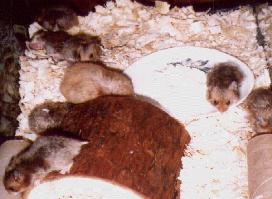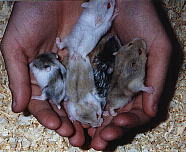Click to return!
Breeding Your Hamster
Care Guide / Breeding F.A.Q. / How to tell the sex of your hamster
BREEDING CONSIDERATIONS
The sex of hamsters can be easily determined. Mature male hamsters possess large, prominent testicles, which often alarm owners who first notice their size and mistake them for tumors. In addition, the genitourinary to anal separation is much wider in males than females, making it possible to sex young hamsters.
PRE-BREEDING TIP: Place the cage in a place where people, drafts, and unwanted heat or light sources will not bother your mother hamster and her young. Handle the mother to the extent that she is perfectly comfortable around humans before breeding her, to prevent her from acting wild or violently when caring for her babies. Do NOT hold the babies, until after they are weaned. Begin to tame them at this early age to prevent them from acting wild, also.

GENERAL
Male hamsters should be first bred at 10 to 14 weeks of age. Females can be bred at the age of 6 to 10 weeks. As the
female
comes into "heat" she will begin assuming a breeding stance with her back swayed and body stretched out. When petted over
her back, she will remain motionless and sway her back even further. A thin mucus will be noticed coming from her vulva on
the next day of the "heat" cycle, which indicates that estrus will occur two days later. For breeding, place the female into the
male's cage about one hour before dark. Closely observe the pair for mating activity or fighting. Females can be very
aggressive towards males and can cause serious injuries. At the first sign of aggression by the female, remove the male; then
try
again the next night. Also, remove the male shortly after a successful mating has taken place. DO NOT KEEP THE MOTHER AND FATHER HAMSTERS TOGETHER AFTER MATING.

Pregnancy is of very short duration in hamsters; lasting only 15 to 16 days. Just before delivery, the expectant mother will become restless and may discharge a small amount of blood from her vulva. Do not handle or disturb her at this time. It is wise to clean her cage two weeks following breeding, so her cage is relatively clean when babies arrive. Litter size ranges from 5 to 10 pups; larger litters are not uncommon. The pups are born hairless with their eyes and ears closed. However, they do already have their front teeth, the incisors.
The babies should be removed from the mother once they are weaned, or can eat by themselves. Their eyes should open at 2 weeks. Do not keep the mother with the father after she has mated, or the children after they can eat by themselves, or they may mate!
Provide ample nesting material and bedding for the new mother and young. Plenty of fresh food and water should be available
before the babies are born. DO NOT disturb the mother and young for any reason duri
 ng the first week or two after birth. If
a
mother hamster seems threatened for any reason, she typically will kill and cannibalize the young. In other instances, she may
stuff the young into her cheek pouches and frantically carry them around the cage looking for a safe place to establish a nest.
Occasionally, pups will suffocate as a result of this activity, especially if the disturbance is prolonged.
ng the first week or two after birth. If
a
mother hamster seems threatened for any reason, she typically will kill and cannibalize the young. In other instances, she may
stuff the young into her cheek pouches and frantically carry them around the cage looking for a safe place to establish a nest.
Occasionally, pups will suffocate as a result of this activity, especially if the disturbance is prolonged.
Young hamsters usually begin eating solid food at 7 to 10 days of age, but are not weaned until 21 to 25 days. Provide food on the cage floor for the young and mother, and also have soaked, softened pellets available for them as well. Make sure that the water bottle is low enough for the weanlings to use, and that they are strong enough to use it; or provide an alternative water source during this time.
If you have any questions about breeding your hamster, please check out the Breeding F.A.Q. before asking any questions. If you don't find an answer, then ask our experts. Please add in what information we didn't provide, to prevent this question from being asked again.